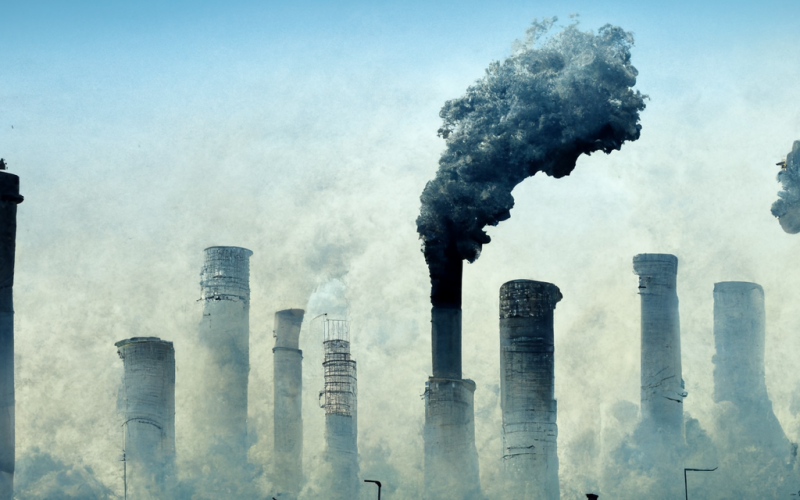Last Updated on April 18, 2024 by Ecologica Life
The Centre for Research on Energy and clean Air (CREA) has released an assessment of the global economic cost of air pollution from fossil fuels. The report, published in 2020, outlines the following:
Economic costs of fossil fuel air pollution were estimated to be US$2.9 trillion in 2018, or 3.3% of global GDP, substantially beyond the likely costs of quick reductions in fossil fuel consumption
Air pollution from fossil fuels emissions caused an estimated 4.5 million deaths in 2018. Each death results in an average loss of 19 years of life.
High levels of fossil fuel particulate matter (PM2.5) pollution was responsible for 1.8 billion lost workdays, 4 million new cases of childhood asthma, and 2 million premature births. These are just some of the health impacts that influence welfare, economic productivity, healthcare expenditures.
If you wish to understand more about types of air pollution, see this article

How air pollution affects the economy
Let’s break it down:
Loss of workforce and decreased productivity
Exposure to air pollution increases risk of diseases like asthma, diabetes, heart disease, stroke and chronic respiratory diseases. This leads to reduced capacity to work, decreased labour participation, and increased health care expenditures. For those who already have health issues, air pollution raises their risk of developing complications from these disorders.
Increased asthma attacks and sick days in children affect learning outcomes at school, increase healthcare costs, and frequently force their caregivers to take time off work. Increased respiratory infections and other minor illnesses in adults increase work absence.
Preterm births linked to air pollution exposure increase healthcare costs and risks of numerous health conditions throughout the lives of the affected babies.
Damaged ecosystems and biodiversity (destruction of natural resources)
The ability of ecosystems to function and thrive is damaged by air pollution, especially sulphur and nitrogen emissions as well as ground-level ozone. Sulphur dioxide and nitrogen oxide emissions cause “acid rain,” which increases the acidity of water, vegetation, and soils and has a negative impact on flora and wildlife.
In the end, acidification has an impact on ecosystems’ capacity to offer “ecosystem services”. These include the provision of water and the cycling of nutrients and carbon, that are essential to the planet and human life.
Accelerated climate change
The first thing that comes to mind when discussing climate change is greenhouse gases. These substances trap the heat from the sun in the earth’s atmosphere and prevent it from radiating out into space. Producing what is known as the greenhouse effect.
Carbon dioxide (CO2) is the gas that is most frequently produced by human activity. Approximately 64% of the global warming caused by humans is due to CO2. CO2 is produced in the extraction and combustion of fossil fuels such as coal and oil. Carbon dioxide can remain in the atmosphere for thousands of years, making its impact on the environment more significant.
Projections for the future of our air
According to forecasts made by the Organisation for Economic Co-operation and Development (OECD), increasing economic activity and energy demand will result in a large increase in worldwide emissions of air pollutants in the absence of new and stricter restrictions.
It is predicted that increasing air pollution emissions will result in greater ground level ozone and PM2.5 concentrations. Average PM2.5 and ozone concentrations are already well above levels recommended by the WHO air quality guidelines for most of the world’s population.
The projected increase in PM2.5 and ozone pollution will in turn lead to substantial effects on the economy and public health. By 2060, the annual number of lost working days will increase from 1.8 billion to 3.7 billion. The number of premature deaths due to air pollution is expected to increase from 4.5 million to 6-9 million per year by 2060, especially in high-density areas like China and India.
How can the air pollution problem be tackled?
If implemented correctly, policies to control air pollution emissions would improve air quality, lower the likelihood of extreme serious health effects, and produce significant co-benefits for the environment. The potential economic repercussions of outdoor air pollution’s effects are serious and emphasise the need for strong legislative action.
There is no one-size-fits-all method for reducing the impacts of air pollution. Policies must be adapted to the unique local conditions because the sources of air pollutant emissions, and the economic effects of air pollution are very unevenly distributed throughout different regions. However, policies that encourage the use of end-of-pipe devices, impose air quality standards, and emission pricing, will certainly help avoid the worst impacts.
In the long term, environmental policy will benefit the economy because it encourages efficient use of resources, and health benefits that would boost GDP by up to 10%. The prices of manufacturing the necessary equipment will be reduced as the market for clean technology expands. Countries that move first expand their possibilities for a growing clean tech industry.








